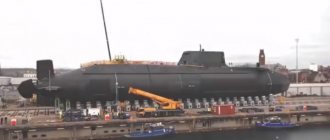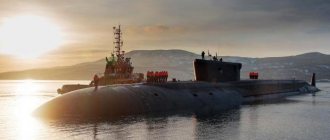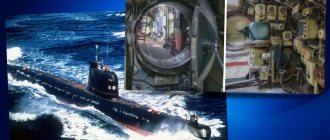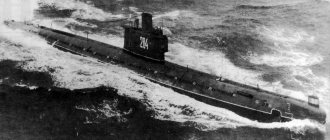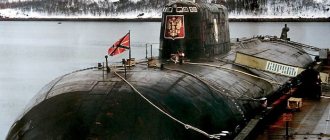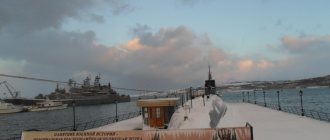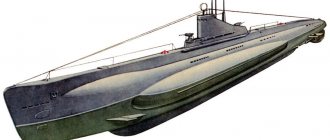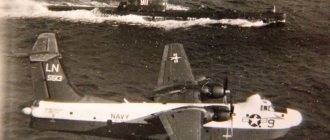How and when did the largest submarine in the world appear?
The creation of this powerful warship is associated with the period of the Cold War and the arms race.
The Akula submarine was supposed to show the superiority of the Soviet navy over the Western one. In 1972, scientists received the task of creating a submarine more powerful, larger, and more dangerous than the Ohio (USA). Work on the Ohio submarine began in the United States in the early 1970s; It was planned to arm the submarine with 24 Trident solid-fuel missiles with a range of more than 7 thousand km, i.e. intercontinental. It was significantly superior to everything that was in service with the USSR, because the huge (with a displacement of 18.7 thousand tons) submarine could launch missiles at a depth of up to 30 m and was quite fast - up to 20 knots.
The Soviet government set the designers the task of creating a Soviet missile carrier, even more powerful than the American one. This work was entrusted to the Rubin design bureau, which at that time was headed by I.D. Spassky, and designer S.N. Kovalev – a leading specialist in this field; 92 submarines were created according to Kovalev's designs.
You might be interested in
Construction began at the Sevmash enterprise in 1976; the first cruiser was launched in 1980, and it passed tests even earlier than the Ohio, work on which began earlier.
Over the entire history of the project, 6 Akula submarines were created, and the seventh, having already begun, was not completed due to the beginning of disarmament. Three of the existing submarines were disposed of with financial assistance from the United States and Canada, two did not have time to be disposed of and now the question of what to do with them next is being decided, and one, the Dmitry Donskoy, was modified and is now in service.
Re-equipping the Sharks is too expensive; it costs the same as it would cost to build two new modern submarines.
"Floating Hilton"
Not only the combat characteristics of the new submarines were unique, but also almost everything connected with them.
The project included the construction of a special submarine training center in Obninsk near Moscow with all the infrastructure for crew members and their families.
It was assumed that each of the "Sharks" would receive three crews - two main and one technical, who would serve on a rotational basis.
The first crew, having completed a combat tour lasting 2-3 months, was supposed to leave the base in the Moscow region, and then go on vacation. At this time, a technical crew was supposed to work on the boat. Upon completion of the repair work, the technical crew handed over the boat to the second main crew, who were rested, had additional training in Obninsk and were ready to go to sea.
Article on the topic
The last parade is coming. The nuclear submarine "Leninsky Komsomol" was scrapped
Much attention was paid to the life of submariners on the boat itself. A relaxation lounge, a sauna, a solarium, a gym, two wardrooms and even a swimming pool - Soviet submariners had never seen anything like this before. As a result, the Sharks received another nickname: the “floating Hilton.”
Prototype:
TK-17 "Arkhangelsk" is a Soviet (later Russian) strategic nuclear submarine, belonging to the 3rd generation, 5th hull in the series. The boat project was developed at the Rubin Central Design Bureau. A total of 6 boats of this project were built, the construction of the seventh boat was suspended, laying was not carried out, and the hull sections were cut into metal. Built at the Sevmash plant, Severodvinsk. The tactical and technical specifications for the design were issued in December 1972. The new type of submarine cruiser was positioned as a response to the US construction of Ohio-class SSBNs (the first boats of both projects were laid down almost simultaneously in 1976). The dimensions of the new ship were determined by the dimensions of the new solid-fuel three-stage intercontinental ballistic missiles R-39 (RSM-52), with which it was planned to arm the boat. Compared to the Trident-I missiles, which were equipped with the American Ohio, the R-39 missile had better flight range characteristics, throw weight and had 10 blocks versus 8 for the Trident. However, the R-39 turned out to be almost twice as long and three times as heavy as its American counterpart. The standard SSBN layout was not suitable for accommodating such large missiles. On December 19, 1973, the government decided to begin work on the design and construction of a new generation of strategic missile carriers. To build the Sharks, a new workshop No. 55 was specially built at Sevmash - the largest indoor boathouse in the world. The ships have a large reserve of buoyancy - more than 40%. When submerged, exactly half of the displacement is accounted for by ballast water, for which the boats received the unofficial name “water carrier” in the navy, and “a victory of technology over common sense” in the Malachite design bureau. One of the reasons for this decision was the requirement for the developers to ensure the smallest draft of the ship to be able to use existing piers and repair bases. Also, it is the large reserve of buoyancy, coupled with a durable deckhouse, that allows the boat to break through ice up to 2.5 meters thick, which for the first time made it possible to conduct combat duty in high latitudes right up to the North Pole. A special feature of the boat’s design is the presence of five habitable durable hulls inside the light hull. Two of them are the main ones, have a maximum diameter of 10 m and are located parallel to each other, according to the principle of a catamaran. At the front of the ship, between the main pressure hulls, are missile silos, which were first placed forward of the wheelhouse. In addition, there are three separate pressurized compartments: a torpedo compartment, a control module compartment with a central control post, and an aft mechanical compartment. The removal and placement of three compartments into the space between the main hulls made it possible to increase the fire safety and survivability of the boat. Two pop-up rescue chambers, designed for the entire crew, are located at the base of the wheelhouse under the retractable device fence. The main armament is the D-19 missile system with 20 three-stage solid-propellant ballistic missiles R-39 “Variant”. These missiles have the largest launch weight (together with the launch container - 90 tons) and length (17.1 m) of the SLBMs put into service. The combat range of the missiles is 8300 km, the warhead is multiplex: 10 warheads with individual guidance of 100 kilotons of TNT each. The entire ammunition load of the Akula missiles can be launched in one salvo with a short interval between the launch of individual missiles. Launch is possible from both surface and submerged positions at depths of up to 55 m and without restrictions on weather conditions.
Reasons explaining the appearance of the steel monster
The huge steel monster, the size of a 9-story building, was a response to the appearance of the Ohio-class nuclear submarine in the US Navy. This submarine could carry 24 intercontinental missiles. Not a single submarine in the USSR possessed such firepower. The presence of such submarines by the enemy negated the existing balance in delivery means, which had been achieved with such difficulty by that time. Project 941, developed in the Soviet Union, could not only deprive the Americans of superiority in the naval component of the nuclear triad, but also provide a certain advantage.
This is what caused the next round of the naval arms race. Work began to boil in Soviet design bureaus and overseas. Each country tried to be the first to create a strategic submarine missile carrier.
Ohio Launch
The reasons for the appearance of a ship of this size are explained by the technical side of the issue. The thing is that the Soviet nuclear submarine was created with the expectation of being ahead of the Americans in terms of the power of its missile salvo. The Project 941 nuclear submarine was supposed to carry on board the new R-39 intercontinental ballistic missiles, which were superior to the American Trident-1 intercontinental missiles deployed on the Ohio-class missile submarines. The Soviet nuclear baton could carry 10 nuclear warheads, instead of the 8 on the American missile, and the R-39 missile flew much further than its American counterpart. The new Soviet rocket had three stages and, according to the project, was supposed to weigh up to 70 tons. Having such technical characteristics of the main weapon, Soviet designers had to solve a difficult task - to create an appropriate launch platform.
In addition, it was planned to immediately install 20 such missiles on the new nuclear submarine missile carrier. The commissioning of new Soviet nuclear-powered ships was supposed to cool the militant ardor of overseas strategists. As foreign sources noted, the Soviet Typhoon-class Shark submarine, according to NATO classification, could wipe out the entire West Coast of the United States with one salvo. The presence of 3-4 missile carriers of this type by the Soviets would threaten the entire territory of the United States, not to mention the vulnerability of the territories of NATO allies.
Loading the missile silo
The enormous destructive power akin to a typhoon strike, which the Soviet submarine possessed, became the reason for it to be given the appropriate name “Typhoon” in the West. According to the classification, Project 941 boats had the code “Typhoon”.
For reference: According to the NATO classification, “Akula” submarines were Soviet multi-purpose submarines of the “Shchuka-B” type of Project 971, built already in the mid-80s. The NATO code “Akula” was assigned to these ships after the name of the lead ship of the K-284 “Akula” nuclear submarine project, which entered service with the Pacific Fleet in 1984.
When did the first submarines appear?
There is vague evidence of an extant 1190 epic, Salman and Morolf, in which the protagonist traveled underwater in a longship submarine with a tightly sealed waterproof leather deck. But the first reliable information about the continuation of man’s assault on the underwater world dates back to the beginning of the 16th century.
The mechanisms, the diagrams of which he found in the papal archives, may not have been implemented, but they gave flight to the creative thought of a genius. The first reliable drawing of a muscle-powered submarine belongs to the great Leonardo.
After him, the history of the development of human assault on the depths accelerates:
- 1538 ─ maritime superpower Spain tests an underwater bell under Emperor Charles V;
- 1620 (approximately) ─ mechanic Cornelius Drebbel with King James I conduct the first launch of a rowing submarine with a crew of 15 people;
- 1716 ─ space explorer Halley invents the supply of oxygen to a diving bell.
His invention was later improved by a pump system. The emergence of a relatively autonomous combat submarine seemed about to take place.
Birth of a record holder
In the Soviet Union, there have already been cases of creating record-breaking equipment. This includes the world's largest transport aircraft, the AN-22 Antey, and the world's first nuclear-powered icebreaker, Lenin. In military terms, the USSR also caused a lot of trouble for the American military, creating excellent military equipment. The latest generation of Soviet intercontinental ballistic missiles caused terror overseas. The navy did not lag behind in this regard, so the world's largest nuclear submarine, the Akula, did not come as a surprise to the Soviet country.
The Soviet ship, built in the early 80s of the 20th century, remains to this day an unsurpassed achievement of design thought. In many technical respects, the new nuclear submarine is rightfully considered the most ambitious Soviet military project. The technical dimensions of the ship alone are amazing, not to mention the cost of building a ship of such scale. The length of the ship is 173 meters, and the width of the hull is 23 meters. The hull of the boat is a steel cigar the size of a 9-story building. Only the draft of the boat was 12 meters. These dimensions also corresponded to the huge displacement. The Soviet submarine missile carrier had the displacement of a World War II battleship - 50 thousand tons.
In terms of displacement, the Akula nuclear submarine was three times larger than its opponent, the Ohio-class submarine. If we talk about the name of the ship, the Soviet version is of folk origin. Even on the slipways, the boat began to be called a shark. This comparison was so successful that it subsequently took root in military and political circles. For the first time in the general public, the new nuclear-powered missile cruiser was called “Shark” by the General Secretary of the CPSU Central Committee L. I. Brezhnev.
The designers of the Rubin Central Design Bureau for Marine Equipment, the flagship of the Soviet shipbuilding industry, handled the task of developing a project for a Soviet underwater super-cruiser perfectly. In 1972, Leningraders received technical assignments for the development of a project for a third-generation strategic nuclear submarine. The design work was headed by the talented Soviet designer S.N. Kovalev, who already had completed and successful projects behind him. His offspring roamed the seas and oceans, remaining a reliable shield of the Soviet state. Since 1973, after the decision of the Soviet government, work on the creation of the project began within the walls of the Rubin Central Design Bureau.
The place where new ships of this size were built was the Sevmash enterprise. For the construction of new ships, a new boathouse of enormous size was specially erected on the shipyard territory. Dredging work was carried out in the water area of the shipyard to allow the passage of ships of such a large displacement.
Three years later, the first lead submarine of Project 941 was laid down on the Sevmash stocks. The ship received the factory index TK-208 (heavy cruiser - 208). In total, it was planned to build 7 ships under this project over the next 10-15 years. It should be noted that Soviet designers managed to overtake their American colleagues by earlier creating a ready-made project for a new submarine missile carrier. The launch of a new Soviet submarine of colossal size in September 1980 came as a real shock to the Americans. The first Ohio-class boat launched in December 1981, when the Soviet missile carrier entered the active fleet.
An interesting detail: of the 6 ships built according to the project, the very first one turned out to be the longest-lived. The KT-208 submarine, launched back in 1981, continues to be in service today. Now this is the TPRKSN (heavy strategic missile submarine cruiser) “Dmitry Donskoy”, KT-208 boat of Project 941.
At home among the whales
The main weakness of the first domestic nuclear submarines was the high noise level, which unmasked them. The Sharks' hulls were designed so well that the noise level was significantly lower than even the designers expected. For the Americans, the “silence” of the “Shark” was an unpleasant surprise. Indeed, it feels somehow uncomfortable to think that somewhere in the ocean a “nine-story building” is moving silently and imperceptibly, with its salvo capable of turning several American megacities into a radioactive desert.
Submariners assure that the “Shark” managed to merge with the ocean so much that whales and killer whales often mistook the missile carrier for a relative, thereby creating an additional “cover” for it.
The appearance of Project 941 Akula missile carriers in the USSR Navy deprived the US military command of hopes of acquiring an overwhelming advantage over the USSR in sea-based nuclear forces.
But big politics intervened in the history of this project. After the collapse of the Soviet Union, US representatives, proposing new disarmament treaties, showed keen interest in the decommissioning and disposal of Soviet Sharks.
TK-202 in 1999, before disposal. Photo: Commons.wikimedia.org
Combat potential
Launch silos of the Typhoon nuclear submarine
In the event of a nuclear conflict, the Typhoon could simultaneously launch 20 R-39 nuclear missiles, each with ten 200-kt multiple warheads, at the enemy. Such a nuclear “typhoon” could turn the entire east coast of the United States into a desert in a matter of minutes.
In addition to ballistic missiles, the boat’s arsenal included more than two dozen conventional and jet torpedoes, as well as Igla MANPADS. The Alexander Brykin transport ship, with a displacement of 16 thousand tons and designed to carry 16 SLBMs, was developed specifically to equip the Typhoons with missiles and torpedoes.
Advantages and disadvantages
“Shark” in the parking lot
With the advent of high-precision strategic ballistic missiles, stationary launch silos began to lose ground in the matter of delivering a guaranteed retaliatory strike. Project 941 nuclear submarines were created to restore this potential.
The advantages of the Akula submarines are represented by three key aspects:
- the possibility of serving in the Arctic, including sub-ice shelves;
- heavy R-39s, which have no analogues among portable strategic missiles;
- increased safety and survivability of the crew and the submarine due to the structural layout.
The appearance of such cruisers in service with the Soviet fleet prompted the United States to sign the SALT-2 treaty. It was these boats that ensured the parity of world powers in the Cold War; their photos still inspire respect and fear of a possible nuclear war.
The shortcomings of Project 941 are controversial. There are complaints about the size caused by the low quality of solid fuel of the R-39, the running properties and controllability of the submarine, noise, and high cost. In modern analytics, there is an opinion that for the USSR it was more important to show scale and power than practical efficiency and expediency.
However, a comparison of performance characteristics with foreign and domestic analogues shows that most of these claims have no significant basis. Certain noise and cost issues do exist, but they are within acceptable limits when adjusted for development time and proportionality.
History of the creation of the 941 Shark project
The confrontation between Russia (USSR) and the West at sea from 1945 to 1970 took place not only in the cold manner of Churchill with a slight technological advantage of the owners of foreign seas, but sometimes in heated fights on distant frontiers. The center of naval power located in the United States has never achieved significant superiority. By 1970, the USSR Navy had become quite balanced, and as a result, a powerful deterrent to the NATO Navy on water, under water and above water - in the natural habitat of the USA and Great Britain. As a result, parity was established between the nuclear powers. The Pentagon had to abandon the preventive destruction of all nuclear facilities of the USSR.
In the early 1970s, the concept of “Realistic deterrence” was adopted against our country. The naval doctrine has changed, based on technological superiority, the search for allies and the ability to negotiate. The end result of the new policy towards the USSR was the “Threat of Unacceptable Damage”, do not forget that in weak states bloody damage is caused daily and consistently. Cunning people from the USA 10/03/1972. concluded an agreement with the USSR “On the Limitation of Strategic Arms,” which meant a reduction in the number of nuclear submarines. Behind the dismissive signature of the president of the English North American colony, Richard Nixon, was the confidence that the “leaders of the Russian Indians” had been fooled.
Since 1970, the Pentagon has relied on its new global project, which in such conditions gives a qualitative advantage - the advanced advanced ballistic missile launch system "Trident" (translated as trident - means three-stage propulsion and Poseidon's weapons). The carrier of 150 ballistic missiles (ballistic missiles) was supposed to be Ohio-class submarines with 24 launchers (launchers), the target being large military facilities and industrial centers of Soviet Russia. In 1971, money poured into the US defense industry to quickly implement the project. Within 10 years, it was expected to launch 10 submarines with the Trident-1 ballistic missile (8 guidance units, deviation 380 m, distance covered 7.5 thousand km).
There was a need to restore parity. In 1973, Sergei Nikolaevich Kovalev was appointed chief designer of the 941 “Shark” project, and Viktor Petrovich Makeev became the chief designer of the R-39 solid-fuel SLBM. This was already the 3rd generation of nuclear submarines. The R-39 missile is three times heavier than the American hastily made Trident-1 analogues and twice as long. This influenced the creation of a fundamentally new cruiser architecture. In 5 years, at Sevmash, using the forces of the USSR economy, the world’s largest boathouse was built (workshop No. 55). In 1981, at the 26th Congress of the CPSU, the head of the country, Brezhnev, informed the world about the creation in the United States of the Ohio submarine with Trident-1 intercontinental missiles, mentioning mainly similar weapons in the USSR. The project of the heavy cruiser 941 “Akula”, laid down on the slipway in 1976, entered service with the USSR Navy on December 12, 1981. under the abbreviation TK-208, also known under his own name “Dmitry Donskoy”.
Comparative assessment
The US Navy has only one series of strategic boats in service - the Ohio, which belongs to the third generation (18 were built, 4 of which were subsequently converted to Tomahawk cruise missiles). The first nuclear submarines of this series entered service simultaneously with the Sharks. Due to the possibility of consistent modernization inherent in the Ohio (including mines with extra space and with replaceable cups), they use one type of ballistic missiles - Trident II D-5 instead of the original Trident I C-4. In terms of the number of missiles and the number of MIRVs, the Ohio surpasses both the Soviet Sharks and the Russian Borei.
It should be noted that, unlike Russian submarines, they are designed for combat duty in the open ocean in relatively warm latitudes, while Russian submarines are often on duty in the Arctic, while being in the relatively shallow waters of the shelf and, in addition, under a layer of ice, which has a significant impact on the design boats. In particular, for Sharks, sea temperatures above +10 °C can cause significant mechanical problems. Among US Navy submariners, diving in shallow waters under the Arctic ice is considered very risky.
The predecessors of the "Sharks" - submarines of projects 667A, 670, 675 and their modifications, were nicknamed "roaring cows" by the American military due to their increased noise; their combat duty areas were located off the coast of the United States - in the range of powerful anti-submarine formations, moreover they had to overcome the NATO anti-submarine line between Greenland, Iceland and Great Britain.
In the USSR and Russia, the main part of the nuclear triad consists of ground-based Strategic Missile Forces.
After the acceptance of strategic submarines of the Akula type into service in the USSR Navy, the United States agreed to sign the proposed SALT-2 treaty, and the United States also allocated funds under the Cooperative Threat Reduction program for the disposal of half of the Sharks while simultaneously extending the service life of their American “peers” until 2023-2026.
On December 3-4, 1997, in the Barents Sea, during the dismantling of missiles under the START-1 treaty by shooting from the Akula nuclear submarine, an incident occurred: while the US delegation was observing the shooting from aboard a Russian vessel, the Los Angeles-class multi-purpose nuclear submarine " made maneuvers near the nuclear submarine "Akula", approaching a distance of up to 4 km. The US Navy boat left the firing area after warning detonation of two depth charges.
TTX nuclear submarine:
Displacement: surface: 23,200 t underwater: 48,000 t Length: 172.6 (TK-208 – 170.0) m Width (hull): 23.3 m Draft (average): 11.2 m Speed: surface: 12 .0 knots submerged: 25.0 kt. Immersion depth: working: 400 m maximum: 500 m Crew: 160 people, incl. 52 officers Endurance: 180 days Armament: 6x533 torpedo tubes (ammunition: 22 torpedoes of type 53-65K, SET-65, SAET-60M, USET-80. Vodopad or Shkval missile torpedoes) 20 R-39 ballistic missiles ( RSM-52) (NATO - SS-N-20 Sturgeon) Information taken from here: https://clck.ru/9ik22 https://www.deepstorm.ru/DeepStorm.files/45-92/nbrs/941/list .htm For the prototype I chose the 5th hull of the boat - TK-17, which later received the name "Arkhangelsk". Laid down on August 9, 1983, launched on December 12, 1986, entered service on December 15, 1987. On February 19, 1988, it was included in the KSF, based in the city of Zapadnaya Litsa. July-September 1988 – first military campaign. On September 27, 1991, during a training launch in the White Sea, a training rocket exploded and burned in a silo. The explosion tore off the cover of the mine, and the warhead of the rocket was thrown into the sea. The crew was not injured during the incident; the boat was forced to undergo minor repairs. On November 18, 2002, the name “Arkhangelsk” was assigned. 2008 – put into reserve. March 19, 2015 – the name “Arkhangelsk” was removed from the ship. Currently in reserve and awaiting disposal. More details about the ship's service here: https://www.deepstorm.ru/DeepStorm.files/45-92/nbrs/941/tk-17/TK-17.htm
Peculiarities
Project 941 Akula submarines were equipped with a power plant consisting of two modules located in different, securely fortified hulls. The condition of the reactors was monitored by pulse equipment, an automatic response system at the slightest loss of power supply.
When issuing a design assignment, one of the mandatory conditions was to ensure the safety of the boat and crew, the so-called safe radius, for which the hull components were calculated using the dynamic strength method and tested experimentally (two pop-up modules, container fastening, hull mating, etc.) .
The Akula class submarine was built at , where the world's largest indoor boathouse, or workshop No. 55, was designed and created especially for it. Project 941 ships are characterized by increased buoyancy - more than 40%. In order for the boat to be completely submerged, its ballast must be half its displacement, which is why the second name appeared - “water carrier”. The decision on such a design was made with a far-sighted aim - repairs and preventive maintenance will be necessary at existing piers and repair plants.
The same reserve of buoyancy ensures the survival of the ship in northern latitudes, where it is necessary to break through thick ice coverings. Project 941 Akula-class submarines cope with the harsh conditions of the North Pole, where ice thickness reaches 2.5 meters with accompanying ice ridges and swells. the ability to break through ice has been repeatedly demonstrated in practice.
Vanguard
The large submarines include the British Vanguard-class submarine. The project was implemented with the construction of four nuclear-powered strategic submarine cruisers in the early 90s of the twentieth century. The first decisions to modernize the submarine fleet and build large boats were made in England in 1983.
The Vanguard boat is a single-hull, 150 meters long and 12.5 meters wide. The boat is equipped with 12 Trident-2 D5 missiles. The boat's missile launch system has been improved. The new launcher significantly reduced the time it took to prepare the rocket for launch.
But the new system also fails. In January 2022, a Trident missile was launched unsuccessfully from the Vanguard submarine. After launch, the rocket deviated from its intended course and fell into the Atlantic Ocean.
All four boats are in service with the Royal Navy. One of the boats is constantly on combat duty in the Atlantic Ocean.
Design features of the Project 941 submarine missile carrier
For the uninitiated, the boat is a huge whale-shaped steel cigar
However, for specialists, special attention is drawn not so much to the size of the ship as to its layout. The submarine has a double-hull design
Behind the outer shell of a lightweight steel body is a dual main robust body. In other words, inside the boat there are two separate hulls located parallel to each other according to the catamaran design. Durable cases are made of titanium alloy. The torpedo compartment, central post and aft mechanical compartments on the ship are placed in closed compartments, capsules.
The space between the two durable hulls is filled with 20 silo launchers. The conning tower is shifted to the rear of the boat. The entire front deck is one big launch pad. This arrangement of launchers implies the possibility of simultaneous launching of all ammunition. In this case, the missiles should be launched with a minimum time interval. The Soviet missile carrier is capable of launching missiles from surface and submerged positions. The working immersion depth for launch is 55 meters.
The ship has 19 compartments, each of which communicates with the others. Horizontal rudders are installed in the light hull of the bow of the boat. The conning tower has a reinforced structure, specially designed for the emergency ascent of the ship in conditions of the presence of a continuous ice sheet on the surface. Increased strength is the main distinguishing feature of Soviet III generation missile carriers. While American Ohio-class nuclear submarines were built to patrol the clear waters of the Atlantic and Pacific Oceans, Soviet submarines mainly operated in the Arctic Ocean, so the ship’s design was created with a safety margin capable of overcoming the resistance of a 2-meter-thick ice shell .
The heart of the nuclear-powered ship is two OK-650VV nuclear reactors with a total power of 380 MW. The submarine is set in motion through the operation of two turbines with a capacity of 45-50 thousand l/s each. Such a huge ship also had propellers of the appropriate size - 5.5 m in diameter. Two 800W diesel generators were installed on the boat as backup engines.
The nuclear-powered missile carrier on the surface could reach a speed of 12 knots. Underwater, a submarine with a displacement of 50 thousand tons could move at a speed of 25 knots. The working diving depth was 400 m. At the same time, the boat had a certain reserve of critical diving depth, amounting to an additional 100 m.
A ship of such large size and with such performance characteristics was controlled by a crew of 160 people. A third of this number were officers. The interior living quarters on the submarine were equipped with everything necessary for a long and comfortable stay. Officers and midshipmen lived in comfortable 2- and 4-berth cabins. The sailors and petty officers lived in specially equipped cubicles. All living areas on the boat were served by an air conditioning system. During long cruises, the ship's crew, free from combat shifts, could spend time in the gym, visit the cinema and library. It should be noted that the ship’s autonomy exceeded all standards existing before that time - 180 days.
